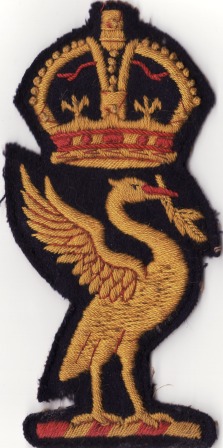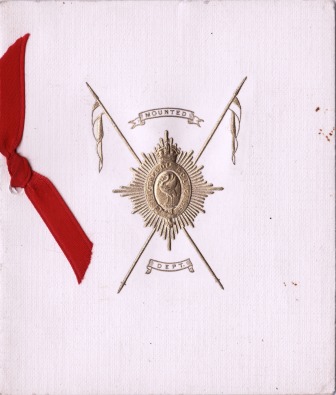A HISTORY OF LIVERPOOL POLICE MOUNTED SECTION by constables david atherton and phil letford, retired
In 1836 the Liverpool City Police Force was established. At this time all transport including Police and Fire services was horse-drawn. The force did not have any form of Mounted Department and any horses used were hired from local “jobmasters”. The Governor of the Main Bridewell was responsible for “Horsing the Prison Vans” and he received an annual allowance for this purpose.
This unsatisfactory state of affairs continued until 1881 when Captain William Nott-Bower was appointed as Head Constable of Liverpool. He embarked on a programme of improvement and modernisation within the Force. In 1885 he submitted a report to the Watch Committee suggesting the formation of a Mounted and Transport Department which would be more efficient and less expensive than the previous system. This report was approved.
In 1886 (125 years ago ) the Mounted Department was formed. Initially, the senior officer designated to be in charge of the Department was appointed direct from the cavalry regiments of the Armed Forces, the first being Troop Sergeant Stephen Sales of the 7th Hussars ( appointed at the rank of Inspector ) at an annual salary of £120.00. Inspector Sales bought the first eight horses later that year and Liverpool became the first Provincial Police Force in Great Britain to maintain a permanent Mounted Department. A Superintendent was then placed in charge of the growing Department and the first man to this rank was one James Nimrod Race, a former rough riding Sergeant Major from the 13th Hussars.
Although the transport of prisoners, patrols and crowd control were the normal duties, one important duty that has long since disappeared was as the despatch orderly. Prior to 1900 there were few telephones in use in Liverpool Police stations. The normal method at this time was for a foot constable to carry it in a despatch bag and travel by tram car. Any message of an urgent or important nature was sent by a Mounted Despatch orderly.
By 1896, the Department could turn out thirty six horses, frequently assisting other Forces. Between 1892 and 1907 recruits for the department came exclusively from the Mounted units of the British Army. The Headquarters of the Department was at Hatton Garden but there were also stables at Old Swan ( Mill Lane ) Esk Street and Ivanhoe Road in Aigburth, as well as the Northern Hospital used specifically for pulling the horse drawn ambulances.
The Headquarters was as stated at Hatton Garden which was also the HQ of the Fire Brigade which was then part of the Police Force. It was said that the horses used for pulling the Fire Engines were so well trained that when the fire bells sounded the horses were released from their stalls and they fell in, in front of the fire engine waiting for the harness which was suspended from the ceiling to be lowered onto them,. The whole operation taking only a matter of minutes, from the bells to leaving the HQ.
In those days the Chief Constable had his own horse drawn transport. In the summer he used a “Phaeton” an open four wheeled carriage, and in winter a “Brougham” a closed carriage.
The early years of the twentieth century provided many opportunities for the use of the Mounted Police. In 1909 there were sectarian riots in Liverpool. In 1911, during a transport strike the Mounted Police not only dealt with rioters but escorted convoys of food desperately needed by the local population.
After such a tumultuous era the following year (1912) saw the first of many successes in the Horse Show ring.
Around this time also several Royal Escorts were performed including two at Chester for the King.
In 1914, the department had an establishment of:
1 Superintendent
1 Inspector
7 Sergeants
54 Constables
There were fifty four horses on the strength and others were hired as and when required. Several of the local forces which were later to form part of our present force had small Mounted Units, these included St Helens, Southport and Wallasey.
The advent of the 1914 -1918 War saw a rapid mechanisation to the Liverpool Police Force. The Police , Fire and Prison vans were motorised and this resulted in a re-organisation of the Mounted Department. The days of horse drawn transport were numbered and this was felt by The Mounted and Transport Department. The first vehicle was a large heavy prison van. This vehicle was used to collect prisoners from outlying stations and bring them to the Main Bridewell for court appearances. This task was formerly carried out by horse transport, the first cool wind of redundancy was felt by the Department as it is shown in the Departments Horse Register:
“ Horse No 20 A Chesnut Gelding, 14 years old, sold on the 4th January 1913 for £19.8s 6d, made redundant owing to the introduction of a motor traction vehicle in the prison van service.
Due to the outbreak of the war in 1914, the younger men went to the army and the older men remained and were joined by civilian drivers.
In 1919 the war was over, the value of the motor vehicle was realised and as the Liverpool City Police was mechanised, the horses were not replaced and by 1924 the Transport Section was completely mechanised and the number of horses reduced to forty -four as below.
By 1924 the strength of the department was reduced to
1 Superintendent
1 Inspector
6 Sergeants
37 Constables
There were now forty- four horses.
During the early years of the Department, the services of a good driver were considered of greater value than those of a good rider, although the mounted men were given a certain amount of appreciation as the following extract from the Standing Orders of 1926 shows:- “ One mounted man who knows how to do his duty is worth a dozen men on foot, but if he does not do his duty discreetly, he may cause twice as much complaint” This bold statement holds true to this very day.
The members of the Mounted Department were then required to work a 12 hour day whilst the remainder of the force worked 8 hours. This was due to the stable duties etc. And for the extra duties they were given a small remuneration. The welfare of the men was obviously given some consideration as Standing Orders 1926 also stated:- “ The Sergeant must not allow any intoxicating drinks to be kept in the station, but may allow a reasonable quantity to be brought in for dinner or supper.”
The department nevertheless, during the years following the Great War built up a high reputation for their equestrian skills and immaculate turnout. A musical ride of sixteen horses was formed as well as a mounted section vaulting and skill- at- arms team.
In 1927, the Gladstone Dock was opened by King George V and once again the Mounted Department provided the escort.
The need for a new more compact and central headquarters for the Mounted Department was recognised. In October 1938 the present headquarters at Greenhill Road was opened. It was considered a very sumptuous place as it also included a large indoor riding school and training field.
It provided accommodation for twenty-seven horses later increasing to twenty –nine. Greenhill Road ( North and South Groves ) also provided accommodation for twenty four mounted personnel in semi -detached housing.
Things seemed to settle down well for the Department in their new HQ but in 1939 During the War twenty seven of the Departments horses were allowed to stabled at Knowsley Hall, home of Lord Derby as a precautionary measure against enemy attack, being looked after by a sergeant and six constables, the horse were later returned to Greenhill Road
During the Second World War the majority of the Mounted Officers were posted to divisions or joined the Armed Forces. Two members of the Department were killed whilst serving with the Royal Air Force.
After the war things returned to normal and our duties at local football matches regularly involved controlling crowds upwards of seventy thousand. There were also escorts for the Lord Mayor of Liverpool. Orange Lodge Processions and various other processions, and demonstrations to be policed.
The department during the years following the war has provided many instances of valuable aid to our divisional colleagues. These include Royal Visits, The World Cup of 1966 The Civic Reception for “The Beatles” , Regular returns to the City by Liverpool and Everton Football clubs for Civic parades.
These duties have been both regular and important parts of the Mounted Department function and the years up to the Force amalgamation in 1974 seem to have been fairly uneventful.
With the creation of the Merseyside Police in 1974 the department took on fresh responsibilities in relation to the large areas that now had to be patrolled. We found that the foreshores of Southport, Crosby, Hoylake and West Kirby ideal for our specialised patrols during the holiday season, we regularly patrol these areas. It is recognised that ground which is either inaccessible or difficult to foot men can more effectively be covered by Mounted Officers on horseback.
Over the years the Mounted Department has been involved in a lot of very high profile duties .
Over the years the Mounted Department has been involved in a lot of very high profile duties .
The Toxteth Riots of 1981 (the horses were deployed for the first night but then withdrawn for public safety reasons)
High Profile Pop Concerts at Aintree Racecourse ( Michael Jackson ) of course not forgetting the Annual Grand National Race Meeting in which the Winner was escorted by the Department with the Officers wearing their Full Ceremonial Dress Uniform, based on the uniform of the 4th Dragoon Guards Regiment.
Including the 1997 Grand National meeting that was cancelled by an IRA Bomb threat were the Mounted Department assisted in clearing the Racecourse of thousand’s of Racegoers.
Christmas Card Liverpool City Police Mounted Dept.
You may also be interested in:
The cost of running the Mounted Police in 1891 PDF



